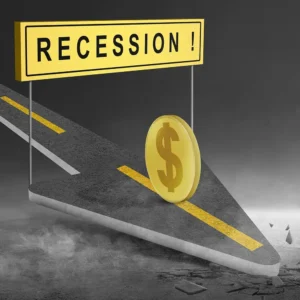- Home
- Blogs
- Recession In US IT Sector And Its Global Impact
Recession In US IT Sector And Its Global Impact
A number of credible sources of information on economic matters are modifying their forecasts and predicting a global recession , a Recession in US IT Sector as businesses face more and more difficulties.
Markets and financial institutions are consequently growing more cautious. There’s concern among many as living expenditures climb.
We’ll look at how analysts anticipate that global recession in US IT sector and how it will impact IT investment in this section.
Key Takeaways:
What Is Recession?

A transitory decline in the economy that lasts for at least six months is known as a recession.
Trade and manufacturing activity are extremely low during this time, which causes the GDP to decline.
In addition, higher unemployment rates during a recession lead to lower incomes and spending.
People suffer during a recession, and the economy also suffers. Consequently, a recession is a bad thing for any economy. This is exactly what Recession in US IT Sector is all about.
The Impact Of A Recession On Businesses

Big and small businesses are both impacted by the recession. Here are a few of the most typical problems that companies of all sizes encounter during a downturn or situation like Recession in US IT Sector!
Diminished Sales
Nothing damages a company during a recession more than when customers stop coming in or when sales start to slowly flow.
A contraction in the economy causes a reduction in aggregate demand, which affects most businesses’ sales. Same it the case with Recession in US IT Sector.
Bankruptcy and Credit Impairment
Tighter loan requirements are among the first things that recessions do to firms.
Lenders become more cautious in the risks they are ready to underwrite when faced with an uncertainly-severed and prolonged downturn or Recession in US IT Sector.
Reductions In Benefits And Employee Layoffs
Both big and small businesses may decide to lay off employees during Recession in US IT Sector in order to decrease expenses, particularly if they need to hire fewer people to handle the decline in demand for their goods and services.
While employee productivity may rise, morale may decline as workloads grow and salary increases stall or cease due to the possibility of more layoffs.
Recession Patterns

The majority of the time, economic growth is interrupted by periodic recessions such as current Recession in US IT Sector.
This compels companies of all shapes and sizes to curtail expenses intended for expansion while simultaneously preparing for a sudden decline in demand.
When a recession hits, small firms are more vulnerable than larger ones.
The strongest survivors in this Recession in US IT Sector might gain market share as rivals falter, setting them up for success in the subsequent economic rebound.
When Is A Recession Deemed To Be "Official"?

Because of the COVID-19 pandemic’s aftershock and Russia’s invasion of Ukraine, the Globe Bank said in June that the globe is headed for a protracted period of sluggish growth and high inflation causing Recession in US IT Sector.
Increased energy prices will, in particular, lower real incomes, raise production costs, tighten financial conditions, and constrain macroeconomic policy in countries that import energy.
While there isn’t a single, widely accepted definition, some have defined a recession as “two consecutive quarters of falling growth.”
Not As Awful As It Was In 2008
Morgan Stanley predicts that the global recession would likely be shorter than expected and less damaging to businesses than previous downturns.
At central banks, interest rates are fluctuating due to Recession in US IT Sector.
Interest rates were raised by the European Central Bank by 50 basis points last month in an effort to “anchor” inflation expectations. Inflation in the EU is at 8.9%.
The Bank of England projects that inflation in the United Kingdom will peak at more than 13% and remain over 10% for most of 2023.
High real estate costs, tight labor markets that led to hiring freezes rather than layoffs, the economy’s relative strength prior to the recession, and the shift toward subscription-based income sources have all been cited as contributing factors.
Technological Downturn?

Although each of these groups focuses on a different topic, the forecasts and analyses of economists and central banks are different from those of commentators on banking and investing.
All business sectors would obviously not be equally affected, even in the case of a similar macroeconomic trend. As we can see for Recession in US IT Sector.
Furthermore, we can say that not all segments of the technology industry will experience the same level of disruption and that these divisions will not occur in equal measure.
“Big Tech is bracing for the economic slump,” according to a July Washington Post article.
This was said to have an impact on markets. The market dynamics can often exaggerate Big Tech’s reputation as a gauge of the overall economy, even though this is true.
Also, when the media talks about “Big Tech,” they’re talking about a wide range of companies, from phone and EV manufacturers to social networking sites.
Actually, because every company nowadays needs to be a technology company to some extent, the idea of the “technology sector” is no longer as relevant as it once was due to Recession in US IT Sector.
Stats Related To Recession In The US IT Sector

Current signs suggest that the US GDP shrank even more in the second quarter due to Recession in US IT Sector .
If that’s the case—and considering that the US GDP shrank by -1,6% in Q1—many in the financial industry are prepared to declare that the country is experiencing a recession.
Short-term recession designations are unlikely to come from the select group of experts tasked with making the decision.
Very contradictory data is the cause. June saw an increase of 376,000 jobs in the US economy. May saw the highest level of inflation since late 1981 concurrently.
Because of how different this stagflation is from previous ones, experts predict that interest rates will climb for the upcoming year.
This circumstance represents the most recent in a string of disruptive events now plaguing the market.
The storm list is never-ending and includes persistent difficulties managing the pandemic; severe shortages of supplies; a notable lack of expertise in IT and related fields; escalating cybersecurity risks; changing environmental laws; and claims of control over digital commerce brought on by the conflict between Russia and Ukraine.
Business executives are now dealing with growing inflation as a result of these changes, and many are expecting a severe downturn in economic growth.
Its A Wrap
An economic downturn lasting a few months is called a recession. When it comes to their effectiveness, a recession and a depression are not the same.
Recession in US IT Sector has several reasons, and these factors change throughout time.
The primary reasons are income disparity, inflation, declining consumer confidence, and job losses.
Although it is possible to forecast recessions, the method is challenging since it is uncertain if the same factors that caused one recession would trigger another.
A deflationary period during a recession can lower prices for discretionary goods, which in turn influences consumers’ purchasing decisions.
However Recession in US IT Sector should not last long as US is a first world country which has overcome similar situations in past and have blossomed impeccably post such adventures.
Experts predict the same coming their way this time around , it definitely will have an impact globally but will heal with time.
FAQ's
In terms of revenue, Canada's Employment and recruiting Agencies sector accounted for $10.1 billion in market share in 2022
Experts claim that record-high job vacancies are being caused by a combination of factors including an ageing population, industry upheavals, and pent-up demand.
15% of HR job postings in the United States and 12.5% in the Canadian provinces and territories are for recruiters.
Also Read:
-
 Top Healthcare Recruitment Agencies in 2024
Top Healthcare Recruitment Agencies in 2024 -
 Top Healthcare Recruitment Agencies in USA
Top Healthcare Recruitment Agencies in USA -
 Top IT recruitment firms in USA
Top IT recruitment firms in USA -
 Best IT Recruiters in Canada
Best IT Recruiters in Canada -
 Best Recruitment Services in USA
Best Recruitment Services in USA -
 Top VMS Recruiting Services in USA
Top VMS Recruiting Services in USA -
 Top Engineering Recruitment Agencies in 2024
Top Engineering Recruitment Agencies in 2024 -
 Top Healthcare Recruitment Agencies in Canada
Top Healthcare Recruitment Agencies in Canada -
 Best IT Recruitment Agencies In USA
Best IT Recruitment Agencies In USA -
 Best Offshore Recruitment Agencies In USA
Best Offshore Recruitment Agencies In USA -
 How Offshore Recruiters are better than In-House Recruiters
How Offshore Recruiters are better than In-House Recruiters -
 How RPO Analytics Experts Are Revolutionizing Recruitment
How RPO Analytics Experts Are Revolutionizing Recruitment -
 How Woman in RPO Foster Innovation & Success
How Woman in RPO Foster Innovation & Success -
 Communication, Collaboration, And Relationship Building in RPO
Communication, Collaboration, And Relationship Building in RPO -
 How RPO's Can Help Startups Recruit Top Talent?
How RPO's Can Help Startups Recruit Top Talent? -
 How RPOs Can Help Businesses Adapt To New Workforce Trends
How RPOs Can Help Businesses Adapt To New Workforce Trends -
 Essential Technologies for Today's RPO Professionals
Essential Technologies for Today's RPO Professionals -
 Best Offshore Sales Recruiters in Canada
Best Offshore Sales Recruiters in Canada -
 Best Offshore Manufacturing Recruiters in Canada
Best Offshore Manufacturing Recruiters in Canada -
 Best Offshore Biotechnology Recruiters in Canada
Best Offshore Biotechnology Recruiters in Canada -
 Best Offshore Finance Recruiters in Canada
Best Offshore Finance Recruiters in Canada -
 Best Offshore Engineering Recruiters in Canada
Best Offshore Engineering Recruiters in Canada -
 Best Offshore Healthcare Recruiters in Canada
Best Offshore Healthcare Recruiters in Canada -
 Best Offshore IT Recruiters in Canada
Best Offshore IT Recruiters in Canada -
 Best Candidate Screening Services in Canada
Best Candidate Screening Services in Canada -
 Best Manufacturing Offshore Recruiters in USA
Best Manufacturing Offshore Recruiters in USA -
 Best Candidate Sourcing Services in Canada
Best Candidate Sourcing Services in Canada -
 Best Offshore Insurance Recruiters in USA
Best Offshore Insurance Recruiters in USA -
 Best offshore Marketing Recruiters in USA
Best offshore Marketing Recruiters in USA -
 Best Offshore Sales Recruiters In USA
Best Offshore Sales Recruiters In USA -
 Best offshore Engineering Recruiters in USA
Best offshore Engineering Recruiters in USA -
 Best offshore Biotechnology recruiters in USA
Best offshore Biotechnology recruiters in USA -
 Best Offshore BFSI Recruiters in USA
Best Offshore BFSI Recruiters in USA -
 Best Offshore Real Estate Recruiters in USA
Best Offshore Real Estate Recruiters in USA -
 Best Offshore Health Care Recruiter In Canada
Best Offshore Health Care Recruiter In Canada -
 Best offshore IT Recruiters in USA
Best offshore IT Recruiters in USA -
 Top offshore Recruitment Services in USA
Top offshore Recruitment Services in USA -
 Best IT Screening Services in USA
Best IT Screening Services in USA -
 Top Recruiting Services in USA
Top Recruiting Services in USA -
 Top Sourcing Services in Canada
Top Sourcing Services in Canada -
 Top Trends to Generate RPO Leads in 2024
Top Trends to Generate RPO Leads in 2024 -
 Best Sourcing Services in Canada
Best Sourcing Services in Canada -
 Best Screening Services in Canada
Best Screening Services in Canada -
 Top Real Estate RPO Services in USA
Top Real Estate RPO Services in USA -
 Top 11 IT Recruitment Agencies In USA
Top 11 IT Recruitment Agencies In USA -
 Best VMS Recruitment Services in Canada
Best VMS Recruitment Services in Canada -
 Top Healthcare RPO Services in USA
Top Healthcare RPO Services in USA -
 Top IT Recruiters in Canada
Top IT Recruiters in Canada -
 Best Engineering Staffing Agencies in Canada
Best Engineering Staffing Agencies in Canada -
 Best IT Staffing Agencies in Canada
Best IT Staffing Agencies in Canada -
 Best Biotechnology Staffing Agencies in USA
Best Biotechnology Staffing Agencies in USA -
 Best Real Estate Staffing Agencies in USA
Best Real Estate Staffing Agencies in USA -
 Best Healthcare Staffing Agencies in Canada
Best Healthcare Staffing Agencies in Canada -
 Best Insurance Staffing Agencies in Canada
Best Insurance Staffing Agencies in Canada -
 Top 360 Degree Recruitment Services In USA
Top 360 Degree Recruitment Services In USA -
 Top Finance Recruitment Specialists in USA
Top Finance Recruitment Specialists in USA -
 Top Engineering Recruitment Specialists in USA
Top Engineering Recruitment Specialists in USA -
 Top Real Estate Recruitment Specialists in USA
Top Real Estate Recruitment Specialists in USA -
 Top Biotechnology Recruitment Specialists in Canada
Top Biotechnology Recruitment Specialists in Canada -
 Best Recruitment Specialist in Canada
Best Recruitment Specialist in Canada -
 What is Recruitment Training and How to Become a Recruiter
What is Recruitment Training and How to Become a Recruiter -
 Best Sales Recruitment Specialist in USA
Best Sales Recruitment Specialist in USA -
 Best Real Estate Recruitment Specialist in USA
Best Real Estate Recruitment Specialist in USA -
 Best HealthCare Recruitment Specialist In USA
Best HealthCare Recruitment Specialist In USA -
 Best IT Recruitment Specialist in USA
Best IT Recruitment Specialist in USA -
 Best Offshore Recruiting Services in 2024
Best Offshore Recruiting Services in 2024 -
 Best Budget Friendly RPO Services In USA
Best Budget Friendly RPO Services In USA -
 Top 10 LATEST RPO TRENDS IN 2024
Top 10 LATEST RPO TRENDS IN 2024 -
 Top IT Recruiters In UK
Top IT Recruiters In UK -
 Best Candidate Sourcing Services in USA
Best Candidate Sourcing Services in USA -
 Best Candidate Screening Services in USA
Best Candidate Screening Services in USA -
 Candidate Sourcing Services In Canada
Candidate Sourcing Services In Canada -
 What is Candidate Screening and how the process works
What is Candidate Screening and how the process works -
 Best RPO Services in USA
Best RPO Services in USA -
 Top RPO Agencies in UK
Top RPO Agencies in UK -
 Sales Recruiters in UK
Sales Recruiters in UK -
 Engineering Recruiters in UK
Engineering Recruiters in UK -
 Best VMS Recruitment Services in UK
Best VMS Recruitment Services in UK -
 Best Recruiting Support Services in 2024
Best Recruiting Support Services in 2024 -
 Top RPO Companies In World
Top RPO Companies In World
Connect with Us
Feel free to drop us a line – we’re here to hear from you and help you in the best possible way

